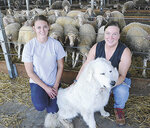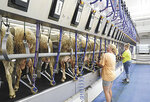JUDA, Wis. – When master cheesemaker Jeff Wideman, Shirley Knox and Mariana Marques de Almeida decided to milk sheep, they wanted to invest in the best-producing breed. However, that breed could not yet be found in the United States. It was the Assaf sheep – which is known for producing large volumes of high-quality milk – and they believed it would be the perfect breed to fill their bulk tank.
Assaf originated in Israel and were refined in Spain. Through the importation of semen from Spain, the three partners began developing Assaf sheep and introducing a breed new to North America. Building a state-of-the-art facility near Juda on the farm where Wideman grew up, they started milking in 2019 after creating their herd from a carefully-selected and specially bred flock of lambs. The dairy sheep operation called Ms. J and Co. now milks around 350 head of sheep. Automation is at the heart of this grade A dairy that employs the latest technology in rearing, milking and managing sheep.
“We started by focusing on developing the genetics and selling semen imported from Spain, and now we are starting to sell breeding stock as well,” said Marques de Almeida, the farm’s senior animal scientist, breeding advisor and cheese specialist. “After three years of milking, our herd of sheep is becoming more and more exclusive. But it will take a few more years to become 100% Assaf.”
Marques de Almeida said the Assaf breed is characterized by long, droopy ears, a roman nose and a fat tail. Currently, the flock contains crosses of East Fresian and Assaf breeds. It takes four generations of crossing to create a sheep that is 93% Assaf, which qualifies it as a purebred. There is one male on the farm that is 100% Assaf, but more are coming.
“Assafs produce a lot of milk,” Marques de Almeida said. “They produce two or three times more than any other U.S. dairy sheep breed. We have some sheep producing up to 13 pounds of milk per day, which is crazy for a sheep.”
The sheep at Ms. J and Co. are producing an average of 1,300 to 1,400 pounds of milk per lactation.
“If a sheep produces less than 1,000 pounds of milk per year, we do not keep her,” Marques de Almeida said. “Our three top ewes each gave over 4,000 pounds in one lactation.”
Sheep are milked twice a day in a 32-stall parlor, and milk weights are recorded every time an ewe enters the parlor. All sheep have an RFID bolus.
“Selecting for the best udder conformation is a big part of our work here as sheep are known for having less desirable teat placement than cows or goats,” Marques de Almeida said.
The barn is currently set up for 800 sheep. The farm’s goal is to expand to 1,600 head and add another 32 stalls in the parlor.
Carissa Brooks is the farm manager.
“We want to focus on genetics before expanding,” Brooks said.
“Moving forward with the best genetics we can is an important part of our plan.”
A weather station on the roof controls the barn’s curtains to ensure optimum comfort indoors.
Sheep reside on a bedded pack, and fresh bedding is added daily.
“That really helps with our somatic cell count and helps keep heat in the barn when it’s cold outside,” Brooks said. “It rarely drops below 32 degrees in here.”
Sheep are divided into groups based on lactation, and each group receives its own ration.
The high-producing group currently averages 7-8 pounds of milk per day. The farm raises hay on 90 acres – a non-GMO alfalfa mixed with four other grasses. The total mixed ration also includes a grain mix of corn, soybean meal, mineral pellets, oat and molasses.
“We compost our bedding and put it back on the fields to close the cycle,” Marques de Almeida said.
Daily milk production on the farm has gone up 1,000 pounds since last year on the same number of sheep, rising from 1,500 pounds to 2,500 pounds. Removing less profitable ewes from the herd has further improved milk averages.
“The setup we have on the dairy, and the bettering of our genetics, has helped us nearly double our milk production,” Marques de Almeida said.
Landmark Creamery picks up a portion of Ms. J and Co.’s milk while the rest is shipped across the U.S. to cheese plants and places that make cheese and yogurt.
“Our original goal was to make cheese, but the demand for sheep milk is so high we decided to sell the milk instead and help develop the sheep milk industry in the U.S.,” Marques de Almeida said. “Sheep milk yogurt is really good, and we’re hoping to sell fluid milk eventually; it could be a great opportunity. All sheep milk is A2, which can make it easier for some people to digest.”
Brooks and Marques de Almeida do the A.I. while rams help with cleanup. Milking and lambing occur year-round at Ms. J and Co. where they do one month of lambing followed by 1.5 months off to clean and disinfect the rooms before bringing in another batch of lambs. The lamb barn contains three rooms, and lambs are housed at a rate of 200 per room when they are still on milk.
“We focus a lot on biosecurity and try to keep each room all in/all out, which means we clean and disinfect between each lambing group,” Brooks said. “It’s a big component of animal health and welfare. Biosecurity is important. It’s the only way we can sell animals all over the U.S. Health and animal welfare are two of our biggest concerns, and we are clean of diseases common for sheep.”
A two-month break from lambing is taken in the summer during the warmest months. After lambing 150 ewes in mid-August, the farm will be milking over 450 head.
For the first few days, lambs are bottle fed colostrum. They are then given whole milk from the farm’s ewes during a three-day transition to milk replacer which is fed free-choice via automatic feeders.
“We created this farm so that people can see that sheep can be profitable and be a good alternative to cows,” Marques de Almeida said. “We want to help others get started. We are now starting to have the genetics that can help them begin at a good point which is important to us. It took us three years to reach the good genetics in milk production and udder conformation, and it is an ongoing focus.”
Born and raised in Portugal, Marques de Almeida came to the U.S. to work on this project after meeting Wideman in 2010 at an international cheese contest. Brooks grew up on a dairy cow farm and has a dairy science degree from the University of Wisconsin-Madison. Fifteen employees, including Marques de Almeida and Brooks, work at Ms. J and Co.
“We are so grateful of the team we have developed over the past few years,” Brooks said. “Our employees are so dedicated to animal health and wellness, and their passion for the ag industry really shines through. Without them, we wouldn’t be where we are today.”
Focused on developing elite Assaf genetics to share with the industry while helping to grow the sheep milk market, Ms. J and Co. is working with farms in New York, Oregon and Missouri to help develop its flocks. Offering expertise in farm facility designs, genetics, breeding programs, reproduction management, and general flock and software management, the farm serves as a source for sheep and goat dairy farmers to obtain the genetics necessary for improving milk production.
“With every lambing, we get better and better genetics,” Marques de Almeida said. “We’re sending DNA on our rams to the Assaf breed association in Spain to be classified using genomics to get more information on these animals. The Assaf breed is one of only two sheep breeds doing this.”
Working with the best bloodlines and facilities to set ewes up for success, Ms. J and Co. hopes to guide others to success as they focus on the genetic advancement of its flock.
“Currently, the U.S. sheep dairy industry is very small, and very few farms are large like ours,” Marques de Almeida said. “We want to develop the markets. Our dream is to prove there is a demand for sheep milk. If more people want to produce this type of milk, we can expand as an industry and ship more product. It’s going slow, and there is still a lot of work to be done, but sheep are starting to get a little more respect here.”


Comments
No comments on this item Please log in to comment by clicking here